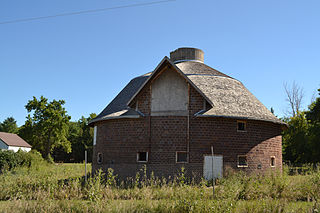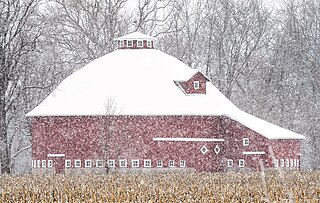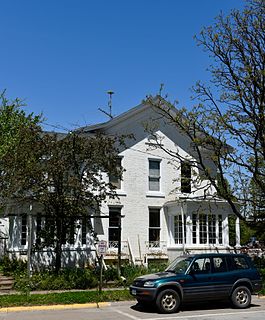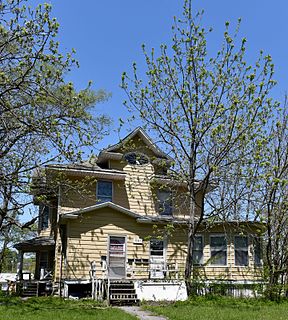
A round barn is a historic barn design that could be octagonal, polygonal, or circular in plan. Though round barns were not as popular as some other barn designs, their unique shape makes them noticeable. The years from 1880–1920 represent the height of round barn construction. Round barn construction in the United States can be divided into two overlapping eras. The first, the octagonal era, spanned from 1850–1900. The second, the true circular era, spanned from 1889–1936. The overlap meant that round barns of both types, polygonal and circular, were built during the latter part of the nineteenth century. Numerous round barns in the United States are listed on the National Register of Historic Places.

The Fred W. Meier Round Barn was a historic building located near Ludlow in rural Allamakee County, Iowa, United States. It was built in 1912 by Fred W. Meier. The building was a true round barn that measures 56 feet (17 m) in diameter. The bottom half of the barn was constructed in stone and featured red horizontal siding, 2-pitch conical roof, aerator and an internal wood stave silo. It was listed on the National Register of Historic Places in 1986. The structure was destroyed in a thunderstorm during the night of July 27, 2002.

The Dyas Hexagonal Barn is an historical building located near Bellevue in rural Jackson County, Iowa, United States. Built in 1921, it features red horizontal siding, a tin roof and a central wood stave silo that extends through the roof. The building is hexagonal in shape and measures 50 feet (15 m) around. It is one of four known round barns that originally had a flat or near flat roof that was built on an Iowa farm. It has been listed on the National Register of Historic Places since 1986.

The Charles B. Reynolds Round Barn was a historic building located near Doon in rural Lyon County, Iowa, United States. It was built in the summer of 1904. In the early 1920s, the original conical roof was damaged due to a windstorm and replaced with a gambrel roof. The building was a true round barn and featured white horizontal siding, a two-pitch sectional roof and an octagon louvered cupola. The barn has been listed on the National Register of Historic Places since 1999. The barn was razed in September 2009.

The Slayton Farms-Round Barn is a historic building located near Iowa Falls in rural Hardin County, Iowa, United States. Frank Slayton had it built in 1915 for use as a dairy barn. The barn is one of 16 that was built by the Johnston Brothers Clay Works from Fort Dodge, Iowa. It is constructed of hollow clay tiles and features a gambrel roof with two different pitches and hay dormer. Two aerators flank the central silo on the roof. The interior of the barn is fashioned around the silo from which silage was shoveled to feed the cattle. An overhead track system and a bucket for hauling materials remains intact. It has been listed on the National Register of Historic Places since 1999.

The R. Bruce and May W. Louden House is an historic building located in Fairfield, Iowa, United States. Original construction is in a colonial revival style and the interior was remodeled in an art deco style in 1928. Louden sold the property in 1948, and it was broken into apartments in the 1960s. The house was built in 1905 and was the residence of R. Bruce and May W. Louden until 1948.

The Bert Leedy Round Barn, also known as Paxton Round Barn and as Fulton County Historical Society Round Barn, is a round barn located in Richland Township near Rochester, Indiana, United States. Built in 1924, it was listed on the National Register of Historic Places in 1993. The listing was consistent with terms of a National Park Service "Multiple Property Documentation" study on "Round and Polygonal Barns of Indiana" that was prepared in 1991. The Round Barn was moved to its current site, an open-air museum, in 1989 after it was struck by a tornado.

The John Haimbaugh Round Barn in Newcastle Township near Rochester, Indiana, United States, is a round barn that was built in 1914. It was listed on the National Register of Historic Places in 1993.

The R. B. and Lizzie L. Louden House, also known as the William and Susan F. Elliott House and the John and Gladdy Ball House, is a historic residence located in Fairfield, Iowa, United States. The single family dwelling was built in 1871 for William and Susan Elliott. The house's historical significance derives from its association with R. B. Louden, who served as the president of the Louden Machinery Company from 1899 through 1939 and his residence here. He and his wife Lizzie substantially remodeled the house in 1900 and 1929, which gives it its eclectic appearance. The latter addition includes two enclosed porches and a sleeping porch designed by Ottumwa, Iowa architect George M. Kerns. The historic designation includes the 2½-story brick house and the 2-story, brick, double garage in the back. It was listed on the National Register of Historic Places in 1999.

The Louden Machinery Company was an American engineering, manufacturing and design company based in Fairfield, Iowa. Founded by William Louden, the company in its early years manufactured and sold the patented hay carrier that he invented in 1867. The company later expanded into a wide variety of farm equipment and, in 1906, began an Architecture Department that reportedly designed more than 25,000 barns from 1906 to 1939. During World War I, Louden's monorail equipment carrier began to be applied to industrial and military applications. By the 1920s, much of the company's revenues were derived from industrial applications of its monorail equipment carriers.

Midway Stock Farm Barn was a historic building located north of Keosauqua, Iowa, United States. The barn was built by William A. Barker around 1880. It gained historical significance when his son Webb installed equipment made by the Louden Machinery Company of Fairfield, Iowa. By doing so he converted the facility from one that raised livestock to a dairy operation. Around 1918 Barker built an addition onto the south side of the barn and installed a litter carrier with tracks and switches on the ground floor, a hay carrier with a steel track and grapple hook hay fork also on the main floor, and a metal aerator on the roof. It was one of a few local operations that still had the Louden equipment in place.

The August and Vera Luedtke Barn is a historic building located north of Fairfield, Iowa, United States in rural Jefferson County. The barn was built by Luedtke from plans prepared by the Louden Machinery Company of Fairfield. He had previously built other barns using the same company's designs in the area. This barn features a gambrel roof, concrete walls, and eleven intact Louden dairy stanchions and a hay carrier system that are original to the building's construction in 1947. Built for a dairy operation, the structure has subsequently been used for storage. The barn was listed on the National Register of Historic Places in 1999.

US Senator James F. Wilson House, also known as the Hamilton House and the Fulton House, is a historic residence located in Fairfield, Iowa, United States. This house was built for attorney William L. Hamilton in 1854. Its notoriety is derived from the residency of James F. Wilson, who lived here from 1863 to 1895.

The R.R. and Antoinette Louden House, also known as the Thomas A. and Dorothy C. Louden House, is a historic residence located in Fairfield, Iowa, United States. R.R. (Roy) Louden was the highly successful manager of the Louden Machinery Company advertising department in the 1920s, and he served as the corporation's secretary from 1931 until his death in 1951. He and his wife Antoinette had this house built in 1925. He lived here until his death in 1951. Their son Thomas and his wife Dorothy lived in the house after his parents. Thomas became general legal counsel for the company in the 1940s. The house is 2½-story, brick Colonial Revival with a side gable roof. It features a wall chimney on the east elevation, a single-story solarium, and a single-story porch on the main facade. An addition was added to the rear of the house in 1956. A two-car attached garage was built onto the addition in the 1980s. The house was listed on the National Register of Historic Places in 1999.

The William and Mary Jane Louden House is a historic residence located in Fairfield, Iowa, United States. It historical significance is derived from its association with William Louden, a co-founder of Louden Machinery Company with his brother R.B. Previously, he secured his first two patents by 1867: one was for hay-stacking, and another was for hay-carrying. He would go on to obtain over 100 more patents. Being the inventive genius of the firm, William brought it to a national reputation in barn construction and farm equipment. The house is a 2½-story, frame, single family dwelling. It was built for the Louden's by C.E. Ward from 1896 to 1897 in the Queen Anne style. The house was listed on the National Register of Historic Places in 1999.

The Louden Monorail System in the Auto Repair Shop, also known as McGuire Motor Company and Crandall's Electric Service, is a historic structure located in Fairfield, Iowa, United States. The monorail system is located in a former auto repair shop along an alley between East Broadway Avenue and East Briggs Avenue. It is the rear, single-story, portion of the building at 117 E. Broadway Ave where the system is located. The storefront portion of the building, also historically associated with the automobile industry, is a two-story brick building built on a stone foundation. The east side of the central business district in Fairfield had become the center for automobile related businesses by the 1920s. Harley Carter bought this building in 1920, and had the monorail system, manufactured by the Louden Machinery Company, installed about 1922. The overhead material handling system is permanently attached to the east wall of the shop. It allowed the mechanics to more easily move the heavy engines and other parts to and from vehicles. The structure was listed on the National Register of Historic Places in 1999.

The Louden Whirl-Around is a historic object located in Fairfield, Iowa, United States. It is a type of a playground merry-go-round manufactured by the Louden Machinery Company. It was built about 1930 on the grounds of the Fairfield Country Club. The octagon-shaped apparatus is composed of steel pipe, malleable iron couplings, and wood. It is located south of the swimming pool behind the clubhouse. Louden had to begin a line of playground equipment in order to acquire patent rights that it needed to develop its line of overhead material handling systems. They acquired the J.C. Porter Company of Ottawa, Illinois, which manufactured the playground equipment and held those rights. The playground apparatus exemplifies the company's growth in the 1920s. Most of the schools in Fairfield had playground equipment manufactured by Louden. The object was listed on the National Register of Historic Places in 1999.

The Iowa Malleable Iron Company was a historic industrial complex located in Fairfield, Iowa, United States. At one time the historic designation included nine buildings, most of them have been torn down. The remaining building was the two-story office building for the factory that was constructed in 1924. Most of the complex was built in 1904 north of the Chicago, Burlington and Quincy Railroad tracks. The company produced malleable iron castings for agricultural implement manufacturers, including Fairfield's Louden Machinery Company. For the most part it was established by the officers of the Louden Company, and it is thought to be the first foundry of its kind between the Mississippi River and Pueblo, Colorado. The two companies maintained a close association throughout their histories. The complex was listed on the National Register of Historic Places in 1999.

The Buresh Farm is located west of Solon, Iowa, United States, along the north shore of Lake McBride. Its historic designation includes five frame structures, the farmhouse and four agricultural buildings. All except one of the buildings is thought to have been built around 1894. The house features a gable roof and wide eaves. It has a root cellar beneath it. The barn, granary and wash house all feature board-and-batten construction. The barn has a wide gable roof that slopes to a shed roof on its north elevation. The granary has a saltbox roof. The wash house was originally built as a summer kitchen. Although its construction date is unknown, the hog house appears to be newer than the rest based on its nonconforming shape. While not particularly unique, the farm buildings are largely unaltered and reflect a late 19th-century agricultural operation that is disappearing from Iowa. The farm was listed on the National Register of Historic Places in 1977.


















